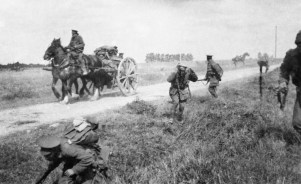 |
Homepage
Actions Maps More..... Mapping
notes
|
|
The Battle of the Marne, 7th-10th September 19146th September 1914 The diary of the 1st Middlesex Regiment records the day's march as follows: "Marched N. again almost over yesterday's ground via Ferrier almost to Chanteloup. After one hour's halt, midday, on to Villeneuve St. Denis, where Battalion bivouacked. In morning Lieut. Evatt and 90 men of first reinforcements joined." This sudden change of front is explained by Field-Marshal Sir John French's message to the troops, dated 6th September, 1914.
7th September 1914 From the British point of view the Battle of the Marne began on 7th September, the Expeditionary Force at dawn holding a line running approximately from Vaudoy-Touquin (Ist Corps)-Lumigny-Faremoutiers--Courtry (IInd Corps)-Villeneuve St. Denis- Villeneuve-le-Comte-Villiers (IIIrd Corps). Throughout the day action was chiefly confined to encounters between de Lisle's Cavalry Brigade and German Cavalry of the 2nd and 9th Guard Cavalry Division. Behind his cavalry the enemy retreated. The 1st Middlesex marched at 8 a.m. to Romain Villiers, thence via Villiers-Dainville to Le Haute Maison. On arrival just south of the latter village rifle fire was heard immediately in front and on the right flank of the Battalion, the remainder of the column having come into action with a German rearguard. 8th September 1914 On the night of the 8th both the 1st and IInd Corps crossed the Petit Morin, the IIIrd Corps remained south of the river, the head of the 4th Division at Le Corbier and the 19th Infantry Brigade at Signy-Signets. The 1st Middlesex, of the latter, had moved out of La Haute Maison at 3.30 a.m. to take up positions for an attack on the high ground about Pierre Levee; the Battalion held the centre of the line, with the Cameronians on the right and the R.W. Fusiliers on the left. The enemy had, however, withdrawn during the night, and the Brigade moved on towards Signy-Signets, the 1st Middlesex as advanced guard.
9th September 1914 Neither on the 9th nor on the 10th September were the 1st and 4th Battalions Middlesex Regiment engaged with the enemy. On the former date at 7 a.m. the 1st Battalion was relieved in its holding positions by the Cameronians, and retired half a mile S. to a covered position, where all ranks rested until 7 p.m. Here 89 men, some who had been "missing" after the Battle of Le Cateau and others discharged from hospital, rejoined. A move was then made to Les Corbiers, where the Battalion bivouacked, the remainder of the 19th Brigade (less the Cameronians) going on to Jouarre. 10th September 1914 The 10th was equally uneventful. At 4 o'clock in the morning the 1st Middlesex rejoined the 19th Brigade, which, with artillery, formed the left flank guard to the 4th Division. The River Marne was crossed by the pontoon bridge at La Ferté sous Jouarre, the stone bridge having been destroyed by the retreating enemy. The Battalion, on reaching the high ground N. of Marcy Fme., entrenched itself and remained there for two hours, covering the main advance. The march was then resumed to Certigny, where the 1st Battalion bivouacked immediately in rear (south) of the 4th Division. The roads traversed by the Battalion on this day everywhere showed evidence of the enemy's hurried retreat; many dead horses were passed and quantities of abandoned artillery ammunition and stores were seen scattered about the roadsides. On the night of the 10th September the British Expeditionary Force lay just south of the River Ourcq, in the angle formed by Lizy, La Ferté Muon and Fère en Tardenois, the valley of the Ourcq and the Marne having been cleared of the enemy. Touch with the Fifth French Army, on the right, and the Sixth French Army, on the left, had been maintained. |
|||
|
